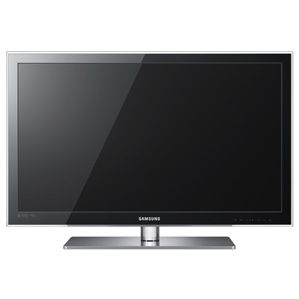This LED from Samsung falls into the all-new TV category of “affordable high-end”, and is likely to appeal to anyone after the latest and greatest slimscreen tech, but who can’t actually afford most incarnations.
Our quick take
If you want a flatscreen that lives up to that moniker, but don't want to pay for frivolous features, Samsung’s UE32C6000 will appeal. Highly capable with SD and HD, but missing Internet connectivity (and 3D compatibility), decent file support via USB ensures reasons to buy this Edge LED set other than pure vanity.

Samsung UE32C6000 - 4.0 / 5
| FOR | AGAINST |
|---|---|
|
|
It is this everyman approach that has helped Samsung reach the heights of Number 1 TV seller in the UK, though this set comes with some shortcomings. The brushed metallic desktop stand might be nice, but it supports a TV with a rather plasticky transparent frame, taking away some of the wow factor created by the TV’s 29.9mm depth.
That startling figure comes from Samsung’s use of Edge LED backlighting, whereby lights are strung around the sides of the panel to fire light across the back. Also inside the set is 100Hz anti-blur engine, four HDMI and two USB slots, as well as the promise of media streaming and networking.
That's an excellent haul for £600, though there are some cut corners: there’s a no-show for Samsung’s ever-improving Internet@TV feature, while Wi-Fi is only for those prepared to pay through the nose for a USB dongle. The rest of us will have to rely on Ethernet LAN for network streaming, though we would argue that most users won't bother exploring that dimension at all unless they happen to have a broadband router alongside the TV. Should we still be in the age of the dongle? By now, Wi-Fi should really be built-in as default.
On the rear are ins and outs for Ethernet LAN, PC (VGA), PC audio, Component video, Composite video, stereo audio ins, and Scart. It’s here where the slimness of this TV starts to play havoc with its usability. Ins and outs on the rear, however all encompassing, and somewhat squeezed into position, with some traditional ports sacrificed for custom-made adaptors. Those for Component video, Scart and Composite video are supplied in the box, so it shouldn't make too much difference, but do bear in mind that not only will you have trailing cables if you wall-mount (and at 29.9mm, you should do), but there could be bulky – and unsightly – connections to be made directly beneath the screen.
A side panel houses the Common Interface slot at its top, while below are two USB slots, an optical digital audio output, and, oddly, four HDMI slots. We do wonder why these are placed on the side because anyone with half decent cable will see them protruding from the sides of the TV. Yuck.
Samsung’s electronic program guide is one of the best in the business; when you press the guide button on the otherwise cluttered remote control, a colourful timetable pops up while the program you are already watching continues underneath, complete with sound. There’s also a thumbnail of the live TV channel in the EPG’s left-hand corner.
Picture quality is a mixed bag. There’s clear evidence of the high-end heritage of this Edge LED TV, but images can sometimes look as flat as the TV itself. Otherwise vivid and as nuanced as you could hope for on any TV, colour is aided by some decent contrast, but can occasionally appear a touch ripe. Cue red faces all round.
Black areas of the image are about as deep as you'll see on any LED TV, though there is a black hole approach, with little detail within. We also noticed a lack of uniformity when it comes to brightness, with some blobs of light in dark screens creating a slight bluish tone.
After tuning in quickly, Freeview HD pictures appear very detailed, very clean and very watchable, while SD channels are almost as good – clear evidence of some excellent upscaling tech.
Another positive characteristic of the picture is a lack of motion blur, and although this feature can introduce a little flatness to proceedings, it’s definitely worth experimenting with – we preferred it left switched-off for all but the most frenetic films.
MP3, DivX, XviD, WMV and MKV (DivX HD) files can all be played via USB, though in our tests no JPEG photos were recognised. When streaming from a PC or Mac, AVC HD files (in MTS format only) proved playable, too, though we couldn’t get the UE32C6000 to recognise MKV files.
The remote control has large buttons, but otherwise fussy labelling; it more closely resembles a bus timetable than the touchscreen controllers we're increasingly used to operating our gadgets with. That said, it does have a nice orange backlit option that will placate anyone planning to use this in a home cinema. And a home cinema might not be a bad addition; sound is weak, with a range of presets flattering to deceive.
To recap
If you want a flatscreen that lives up to that moniker, but don't want to pay for frivolous features, Samsung’s UE32C6000 will appeal. Highly capable with SD and HD, but missing Internet connectivity (and 3D compatibility), decent file support via USB ensures reasons to buy this Edge LED set other than pure vanity
